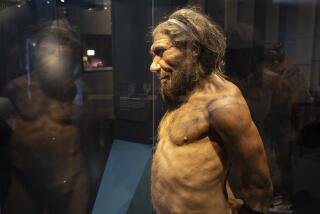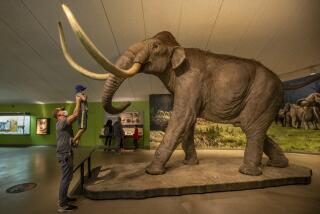How We Became the Way We Are : CHILDREN OF THE ICE AGE: How a Global Catastrophe Allowed Humans to Evolve,<i> By Steven M. Stanley (Crown/Harmony Books: $25; 278 pp.)</i>
- Share via
In 1925, during the Scopes “Monkey” trial, the fundamentalist politician William Jennings Bryan, defending the biblical account of creation, complained to the court: “There is no place for a miracle in this train of evolution.”
The more we learn about human evolution, however, the more it begins to look wonderful, if not miraculous. I was reminded once again of this fact in reading Steven M. Stanley’s fascinating book, “Children of the Ice Age.” Stanley, a professor of paleobiology at Johns Hopkins University, was one of the first proponents of the new theory of evolution proposed by Niles Eldredge of the American Museum of Natural History in New York and Stephen Jay Gould of Harvard University. This theory (given the unaccountably hideous name of “punctuated equilibrium” or “punctualism”) challenged the view that evolution was a smooth, gradual process of incremental change, in which new species flowered while others withered away.
In the theory of punctualism, evolution is a jerky, hysterical affair. Long intervals of evolutionary stasis (if not stagnation) are periodically interrupted by catastrophic periods of change, from which new species spring fully formed, as if from the head of Zeus.
In “Children of the Ice Age,” Stanley brilliantly applies the theory of punctualism to our own evolution as a species. (The subtitle: “How a global catastrophe allowed humans to evolve,” sums up its punctuational roots.) The story of human evolution Stanley presents here is only part of his own research, and not all the ideas are new. Taken together, however, it is an original and important piece of work.
In an old-fashioned tradition of scientific generalism, the author draws on a wide range of disciplines to make his case: from neurophysiology, linguistics and cognitive science to geophysics, biology and climatology. Stanley has been attacked in the past for venturing into fields that are not strictly his own, and this book makes for an eloquent reply to those critics; this grand theory of human origins could only have been born from a generalist approach. (Stanley does make the occasional error when venturing too far afield--as when he confuses protons and neutrons in defining “isotope”--but these slips are insignificant.) He is opinionated and willing to fight anyone on the block, which makes for good reading and some lively asides.
Stanley’s version of human evolution has the simplicity of any good scientific theory. He starts by knocking down one of the central pillars of the standard theory: that the evolution of a bipedal posture automatically triggered the evolution of a large brain. He points out that Australopithecus, the precursor to our genus, walked upright and lived through more than 100,000 generations without evolving a larger brain or a stone culture. In short, the genus stagnated.
The australopithecines, while bipedal, were also tree climbers. Indeed, their ability to flee up a tree was essential to their survival, for Africa was infested with “a motley squadron of vicious predators,” including hyenas, false saber-tooth cats and lions that preyed heavily on these slow, naked primates. This situation continued until about 2.4 million years ago, when catastrophe struck. The beginning of the ice age caused a cooling and drying of the African continent. The copses of trees that the australopithecines needed for protection began to shrink and disappear. Suddenly, the australopithecines were forced to live on the ground; as Stanley puts it, “Nature threw Australopithecus to the lions.”
At this point, Australopithecus probably should have become extinct. But one or more populations managed to survive, because a rapid increase in brain size allowed them to cooperate and strategize in defending themselves against predators. It was not for hunting, but for defense, that we needed high intelligence. The first hominids were not fearless hunters striding tall across the veldt; they were frightened, sneaky primates who outwitted their bloodthirsty predators. (This may explain our apparent antipathy toward big predatory mammals, many of which we have driven close to extinction for no logical reason.)
The bigger brain of Homo did not come without a heavy cost. Much of the brain’s development had to take place after birth--otherwise the head would have been too big to fit through the female’s pelvis. This is why human babies are born undeveloped and helpless--in essence, prematurely--so that they can undergo an enormous surge of brain growth in the first year of life. The result is that a human baby must be carried everywhere for more than a year after birth. australopithecines (like chimps and orangutans) probably gave birth to babies with more fully developed brains who could cling for dear life to their mothers while they climbed trees.
The conclusion is straightforward: Australopithecines could not have evolved a larger brain as long as they climbed trees, even part time. Only when they became completely terrestrial could they then schlep around the feeble infants that the larger brain produced. This explains the long stagnation of the australopithecines, followed by their sudden evolution into Homo at the beginning of the ice age. It was a classic punctuational event.
Helpless infants that needed to be carried around were a huge handicap, especially in times of danger or travel. Evolution, Stanley points out, is severely limited by the raw material at hand, and compromises are sometimes necessary. The evolutionary trade-off of helpless infants for larger brains, Stanley writes, “must stand as one of the most remarkable evolutionary compromises in the history of life.” Anyone with an infant--and I have a 10-month-old at home--would realize just how profound this trade-off was: If you think it is hard caring for a baby with all the amenities of modern life, think how much more difficult it was for naked hominids scratching out an existence on an African plain swarming with hungry meat-eaters.
The helpless infant caused a secondary revolution in hominid social structure. The female, unlike her australopithecine ancestor, needed help caring for her infants. This led to male-female pair bonding, with the father participating in child-rearing. In promiscuous species, which the australopithecines probably were, the paternity of infants was unknown, and fathers could play no special role in raising their offspring. Thus monogamy was born.
The need for increased cooperation in hunting and defense encouraged male-male bonding. And it, too, favored monogamy, since males could work together more effectively if they knew that an exclusive mate awaited each one at home. In promiscuous primate species, such as chimps, the males are constantly vying over any female in heat. (This development also explains the “hiding” of the estrus cycle in human females.)
“Children of the Ice Age” goes on to tell the complete story of human evolution, from the appearance of Homo erectus and its migration out of Africa to the evolution of Homo neanderthalensis and Homo sapiens. It also touches on such milestones in our history as the discovery of fire, the awakening of a belief in an afterlife and the birth of creativity.
In one of Stanley’s earlier books, “The New Evolutionary Timetable: Fossils, Genes & the Origin of Species” (Basic: 1981), he discussed our species’ shift from natural selection to “unnatural selection” caused by our unprecedented mastery of nature. He ends this book on a similar note. “Natural selection,” he writes, “produced certain traits to the benefit of our distant ancestors and then failed to remove these features after they had lost their value.” One of these traits, aggression, now combined with the power of modern weaponry, he argues, has become deeply maladaptive. “The human genus,” Stanley writes, “may orchestrate its own downfall 2 1/2 million years after blind chance allowed it to emerge in a perilous, thinly wooded African Eden.”
“Children of the Ice Age” tells a wonderful story, written by one of the finest thinkers in the field. While his writing doesn’t contain the whimsical digression and playful conceits of another leading author of evolution, Stephen Jay Gould, it is clear, direct and readable. Not since Richard Rhodes’ “The Making of the Atomic Bomb” have I been so captivated by a nonfiction book. I found myself reading “Children of the Ice Age” with an emotion akin to religious awe. Almost every culture has pondered the origin of human beings, and many enchanting theories have been advanced to explain it--from the epic Navajo Dine Bahane to the Judeo-Christian account of Genesis. I find Stanley’s version of human origins no less beautiful for being science, and no less awe-inspiring for being a testable theory. “We cannot know ourselves deep to the core,” Stanley writes, “without understanding our origins.”
More to Read
Sign up for our Book Club newsletter
Get the latest news, events and more from the Los Angeles Times Book Club, and help us get L.A. reading and talking.
You may occasionally receive promotional content from the Los Angeles Times.







